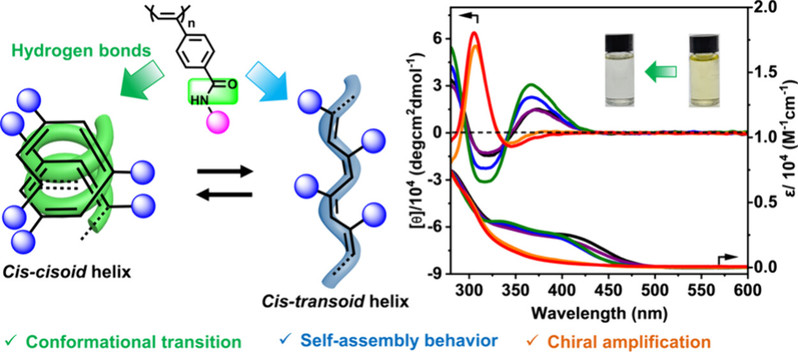Hydrogen Bond-Modulated Conformational Transition, Chiral Amplification, and Self-Assembly Behavior of Substituted Poly(phenylacetylene)s
Liyuan Shi1, Xiaodie Zhu1, Xiaoqian Sun2, Xiaohong Li1(李晓虹)*, Sheng Wang1(汪胜)*
1Jiangsu Key Laboratory of Advanced Functional Polymer Design and Application, College of Chemistry, Chemical Engineering and Materials Science, Soochow University, Suzhou 215123, China
2Beijing National Laboratory for Molecular Sciences, Key Laboratory of Polymer Chemistry and Physics of Ministry of Education, College of Chemistry and Molecular Engineering, Peking University, Beijing 100871, China
Macromolecules 2025,58, 9098–9109
Abstract:A series of chiral para-substituted poly(phenylacetylene)s (PPAs) with diverse benzamide-type pendants was designed and synthesized. By altering the pendant’ s steric hindrance, solvent polarity, and temperature, the elongation and screw sense of helical conformations could be readily tuned. In a polar solvent, all PPA backbones displayed an extended cis–transoid helix owing to the disruption of intramolecular hydrogen bonds. With the addition of a low-polar solvent, the cis-transoid helix could be transformed to a compressed cis-cisoid helix for PPAs containing small chiral amide pendants, attributed to the construction of intramolecular hydrogen bonds. For PPAs with a large pendant, its mainchain elongation did not change, but the helical reversion occurred with the reduced solvent polarity. Lowering the temperature could favor the stability of intramolecular hydrogen bonds, thereby facilitating the enhancement of optical activity. Based on the strong hydrogen bonds between amide groups, these PPAs could self-assemble into suprahelical fibers in low-polar solvents. Furthermore, a class of random copolymers was synthesized to study the effect of conformational transition on the chirality amplification behavior. The copolymers displayed a better chirality amplification behavior in compressed cis-cisoid helix compared with that in cis-transoid helix due to the enhanced interactions between chiral and achiral units in compressed helix.

Article information: https://doi.org/10.1021/acs.macromol.5c01326